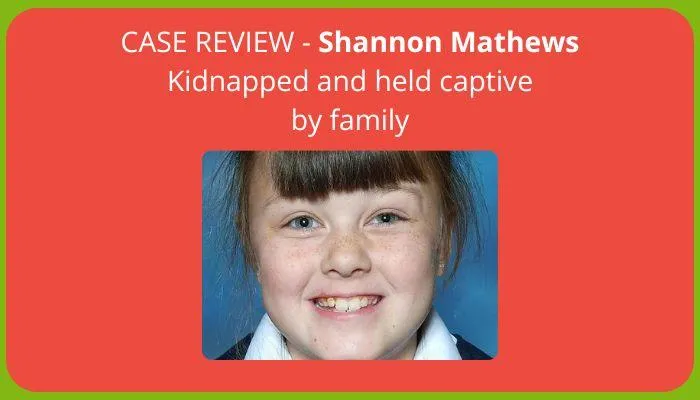Every child's well-being matters.
Case Review Articles
Quick access:
VICTIMS
ADULT ACTIONS
Alison Kelly – data issue
Amina Noor (FGM)
Quick access:
VICTIMS
ADULT ACTIONS
Alison Kelly – data issue
Amina Noor (FGM)

Shannon Mathews
In February 2008, nine-year-old Shannon Matthews was reported missing in Dewsbury, West Yorkshire, sparking a large-scale search operation. The case captured national attention and highlighted vulnerabilities in safeguarding processes.
After 24 days, Shannon was found alive, hidden in a flat by her mother’s partner’s uncle, Michael Donovan. Shannon was restrained inside a divan bed. It emerged that her mother, Karen Matthews, had orchestrated the abduction to claim a monetary reward.
Both were convicted of kidnapping, false imprisonment, and perverting the course of justice. Cruicially, during the trial, it was revealed that Shannon had been given temazepam, a sedative, for up to 20 months before her disappearance - indicating a longer period of abuse leading up to the confinement. She suffered recurrent nightmares following the incident.
Safeguarding and Wellbeing: Lessons Learned
Shannon's case offers valuable insights into safeguarding practices for all children. The following lessons are critical:
Early Identification of Risk Factors
Professionals working with Shannon’s family missed signs of neglect and dysfunction. In early years settings, regular observations and assessments can identify risk factors like inconsistent care, developmental delays, or changes in behaviour that may indicate neglect or abuse.
Inter-Agency Collaboration
Poor communication between agencies contributed to the failure to provide effective support to Shannon’s family. Strong inter-agency collaboration ensures a coordinated response to safeguarding concerns, reducing the risk of children slipping through the cracks.
Parental Support and Education
Karen Matthews displayed limited parenting skills and financial desperation. Early years settings can provide targeted support, such as parenting workshops, to equip families with the tools they need to provide safe and nurturing environments.
Building Trust with Families
Establishing trusting relationships between early years practitioners and families encourages open communication and makes it easier to identify and address safeguarding concerns early on.
Key Recommendations for Safeguarding
Conduct regular training for staff on recognising signs of neglect and abuse.
Implement robust systems for sharing information between agencies.
Offer family support services to address challenges before they escalate.
Ensure that safeguarding policies are clear, accessible, and consistently followed.
By prioritising proactive safeguarding measures, early years professionals can play a vital role in preventing similar incidents and supporting children’s safety and wellbeing.
AUTHOR:- Iona has nearly 10 years of experience supporting nurseries and childminders in curriculum planning, leadership, and safeguarding. Her writing is informed by public information and sector insight, aiming to provide accessible, practical support for professionals working with children. She is part of the On the Button team, helping deliver Well-being, Safeguarding and Complaint Management Software that empowers practitioners to identify concerns early and act confidently.
On the Button provides innovative software tailored to the needs of the early years sector, with a strong focus on EYFS well-being and early years safeguarding. Our tools help senior practitioners to confidently track concerns, maintain robust records, and respond effectively — all while meeting statutory guidance. From early years complaint management to team-wide safeguarding alerts, our platform puts children's safety and emotional health first.

Shannon Mathews
In February 2008, nine-year-old Shannon Matthews was reported missing in Dewsbury, West Yorkshire, sparking a large-scale search operation. The case captured national attention and highlighted vulnerabilities in safeguarding processes.
After 24 days, Shannon was found alive, hidden in a flat by her mother’s partner’s uncle, Michael Donovan. Shannon was restrained inside a divan bed. It emerged that her mother, Karen Matthews, had orchestrated the abduction to claim a monetary reward.
Both were convicted of kidnapping, false imprisonment, and perverting the course of justice. Cruicially, during the trial, it was revealed that Shannon had been given temazepam, a sedative, for up to 20 months before her disappearance - indicating a longer period of abuse leading up to the confinement. She suffered recurrent nightmares following the incident.
Safeguarding and Wellbeing: Lessons Learned
Shannon's case offers valuable insights into safeguarding practices for all children. The following lessons are critical:
Early Identification of Risk Factors
Professionals working with Shannon’s family missed signs of neglect and dysfunction. In early years settings, regular observations and assessments can identify risk factors like inconsistent care, developmental delays, or changes in behaviour that may indicate neglect or abuse.
Inter-Agency Collaboration
Poor communication between agencies contributed to the failure to provide effective support to Shannon’s family. Strong inter-agency collaboration ensures a coordinated response to safeguarding concerns, reducing the risk of children slipping through the cracks.
Parental Support and Education
Karen Matthews displayed limited parenting skills and financial desperation. Early years settings can provide targeted support, such as parenting workshops, to equip families with the tools they need to provide safe and nurturing environments.
Building Trust with Families
Establishing trusting relationships between early years practitioners and families encourages open communication and makes it easier to identify and address safeguarding concerns early on.
Key Recommendations for Safeguarding
Conduct regular training for staff on recognising signs of neglect and abuse.
Implement robust systems for sharing information between agencies.
Offer family support services to address challenges before they escalate.
Ensure that safeguarding policies are clear, accessible, and consistently followed.
By prioritising proactive safeguarding measures, early years professionals can play a vital role in preventing similar incidents and supporting children’s safety and wellbeing.
AUTHOR:- Iona has nearly 10 years of experience supporting nurseries and childminders in curriculum planning, leadership, and safeguarding. Her writing is informed by public information and sector insight, aiming to provide accessible, practical support for professionals working with children. She is part of the On the Button team, helping deliver Well-being, Safeguarding and Complaint Management Software that empowers practitioners to identify concerns early and act confidently.
On the Button provides innovative software tailored to the needs of the early years sector, with a strong focus on EYFS well-being and early years safeguarding. Our tools help senior practitioners to confidently track concerns, maintain robust records, and respond effectively — all while meeting statutory guidance. From early years complaint management to team-wide safeguarding alerts, our platform puts children's safety and emotional health first.
Quality Early Years Ltd.,
Dickens House,
Guithavon Street,
Witham, Essex,
England, CM8 1BJ
© Quality Early Years Ltd 2025
On the Button are Finalists for 3/3 Early Years Awards!
Find On the Button
on Social Media

